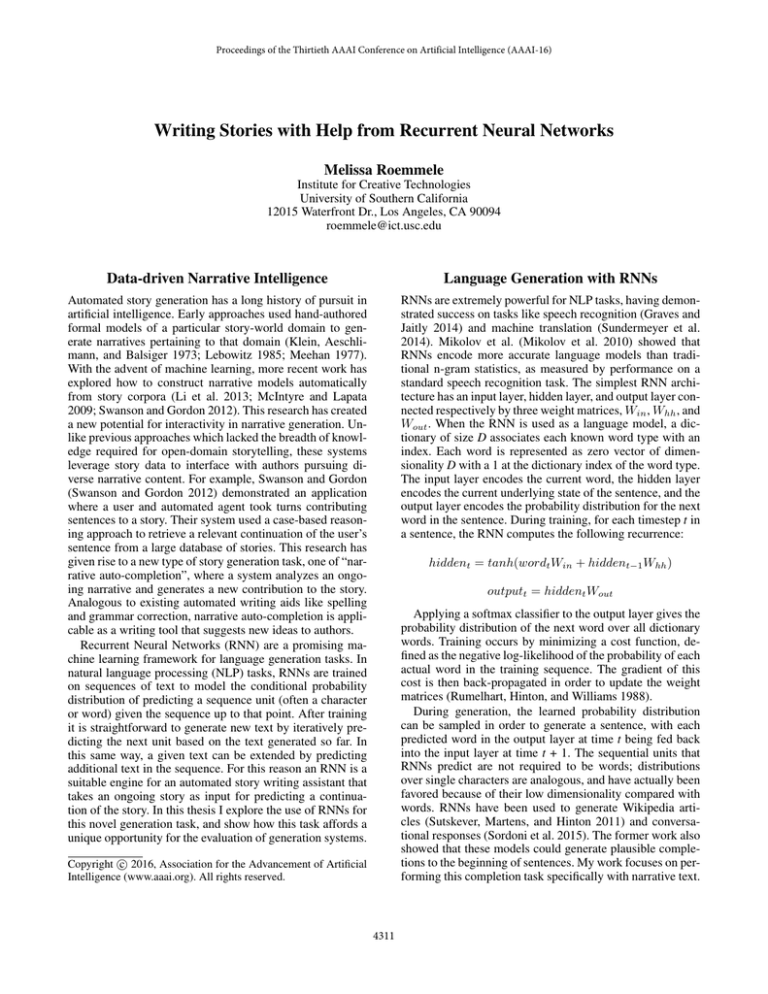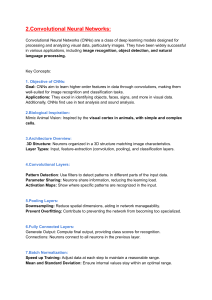
Proceedings of the Thirtieth AAAI Conference on Artificial Intelligence (AAAI-16)
Writing Stories with Help from Recurrent Neural Networks
Melissa Roemmele
Institute for Creative Technologies
University of Southern California
12015 Waterfront Dr., Los Angeles, CA 90094
roemmele@ict.usc.edu
Data-driven Narrative Intelligence
Language Generation with RNNs
Automated story generation has a long history of pursuit in
artificial intelligence. Early approaches used hand-authored
formal models of a particular story-world domain to generate narratives pertaining to that domain (Klein, Aeschlimann, and Balsiger 1973; Lebowitz 1985; Meehan 1977).
With the advent of machine learning, more recent work has
explored how to construct narrative models automatically
from story corpora (Li et al. 2013; McIntyre and Lapata
2009; Swanson and Gordon 2012). This research has created
a new potential for interactivity in narrative generation. Unlike previous approaches which lacked the breadth of knowledge required for open-domain storytelling, these systems
leverage story data to interface with authors pursuing diverse narrative content. For example, Swanson and Gordon
(Swanson and Gordon 2012) demonstrated an application
where a user and automated agent took turns contributing
sentences to a story. Their system used a case-based reasoning approach to retrieve a relevant continuation of the user’s
sentence from a large database of stories. This research has
given rise to a new type of story generation task, one of “narrative auto-completion”, where a system analyzes an ongoing narrative and generates a new contribution to the story.
Analogous to existing automated writing aids like spelling
and grammar correction, narrative auto-completion is applicable as a writing tool that suggests new ideas to authors.
Recurrent Neural Networks (RNN) are a promising machine learning framework for language generation tasks. In
natural language processing (NLP) tasks, RNNs are trained
on sequences of text to model the conditional probability
distribution of predicting a sequence unit (often a character
or word) given the sequence up to that point. After training
it is straightforward to generate new text by iteratively predicting the next unit based on the text generated so far. In
this same way, a given text can be extended by predicting
additional text in the sequence. For this reason an RNN is a
suitable engine for an automated story writing assistant that
takes an ongoing story as input for predicting a continuation of the story. In this thesis I explore the use of RNNs for
this novel generation task, and show how this task affords a
unique opportunity for the evaluation of generation systems.
RNNs are extremely powerful for NLP tasks, having demonstrated success on tasks like speech recognition (Graves and
Jaitly 2014) and machine translation (Sundermeyer et al.
2014). Mikolov et al. (Mikolov et al. 2010) showed that
RNNs encode more accurate language models than traditional n-gram statistics, as measured by performance on a
standard speech recognition task. The simplest RNN architecture has an input layer, hidden layer, and output layer connected respectively by three weight matrices, Win , Whh , and
Wout . When the RNN is used as a language model, a dictionary of size D associates each known word type with an
index. Each word is represented as zero vector of dimensionality D with a 1 at the dictionary index of the word type.
The input layer encodes the current word, the hidden layer
encodes the current underlying state of the sentence, and the
output layer encodes the probability distribution for the next
word in the sentence. During training, for each timestep t in
a sentence, the RNN computes the following recurrence:
hiddent = tanh(wordt Win + hiddent−1 Whh )
outputt = hiddent Wout
Applying a softmax classifier to the output layer gives the
probability distribution of the next word over all dictionary
words. Training occurs by minimizing a cost function, defined as the negative log-likelihood of the probability of each
actual word in the training sequence. The gradient of this
cost is then back-propagated in order to update the weight
matrices (Rumelhart, Hinton, and Williams 1988).
During generation, the learned probability distribution
can be sampled in order to generate a sentence, with each
predicted word in the output layer at time t being fed back
into the input layer at time t + 1. The sequential units that
RNNs predict are not required to be words; distributions
over single characters are analogous, and have actually been
favored because of their low dimensionality compared with
words. RNNs have been used to generate Wikipedia articles (Sutskever, Martens, and Hinton 2011) and conversational responses (Sordoni et al. 2015). The former work also
showed that these models could generate plausible completions to the beginning of sentences. My work focuses on performing this completion task specifically with narrative text.
c 2016, Association for the Advancement of Artificial
Copyright Intelligence (www.aaai.org). All rights reserved.
4311
Automated Story Writing Assistance
References
This thesis envisions the task of narrative auto-completion
applied to helping an author write a story. My advisor and I
have built an application called Creative Help that provides
this type of automated writing assistance (Roemmele and
Gordon 2015). In this application, a user writes a story and
when she types \help\, the application returns a suggested
next sentence which the user can edit like any other text in
the story. Creative Help tracks modifications to suggestions
as a means of evaluating their quality. Performance is quantified as the rate at which users edit suggestions, based on
the assumption that suggestions with fewer edits (including
deletions) are perceived as better continuations of the story.
This functionality addresses a existing weakness in language
generation research: unlike classification tasks, there is no
single gold standard with which to compare generated output, making it difficult to quantify system performance. Creative Help offers a new paradigm for evaluating language
generation organically through user interaction with the application, avoiding the need to conduct evaluation separately
from generation.
The previous approach to generation in Creative Help
used information retrieval methods to find stories similar to
the user’s story among a large corpus, and then extract sentences from these stories as suggested continuations. While
this approach often generated relevant suggestions, the suggestions modeled the context of their originating story rather
than the user’s story, limiting their compatibility. RNNs
make context-sensitive predictions from aggregated data and
thus are more likely to avoid this problem of poorly adapted
content.
The goal of my thesis is to implement an RNN-based system for story generation applied to the context of assistive
story writing that I have described. I plan to use the evaluation functionality of Creative Help to compare RNNs to
alternative approaches such as the described case-based reasoning method. Additional research questions likely to arise
from this work are the following: is the word-based language
model sufficient for modeling narrative, or are there other
structures that should be explicitly modeled (e.g. clauses,
sentences, paragraphs)? Is it possible to capture abstract narrative features like plot, theme, and character development
by modeling low-level structural units? Can RNNs be used
to not just predict narrative text in sequential order but also
in the reverse direction (i.e. predict text that occurs before a
particular part of the story)? The first step in precisely defining such research questions is to implement an RNN-based
generation framework as it is described here. The evaluation of this framework will reveal the specific challenges that
must be resolved in modeling narrative with RNNs. At the
current time (September 2015), two requirements of this thesis have already been fulfilled: a dataset of 20 million stories
has been prepared, and the story writing assistant (Creative
Help) interface has been built. By February 2016, I plan
to have completed training the initial RNN model and begun experiments using the writing assistant to evaluate the
model. Further work after this will examine potential solutions to the most important problems associated with RNNbased narrative generation.
Graves, A., and Jaitly, N. 2014. Towards end-to-end speech
recognition with recurrent neural networks. In Proceedings
of the 31st International Conference on Machine Learning,
1764–1772.
Klein, S.; Aeschlimann, J.; and Balsiger, D. 1973. Automatic novel writing: A status report. Wisconsin University.
Lebowitz, M. 1985. Story-telling as planning and learning.
Poetics 14(6):483–502.
Li, B.; Lee-Urban, S.; Johnston, G.; and Riedl, M. 2013.
Story Generation with Crowdsourced Plot Graphs. In 27th
AAAI Conference on Artificial Intelligence.
McIntyre, N., and Lapata, M. 2009. Learning to tell tales:
A data-driven approach to story generation. In Proceedings
of the Joint Conference of the 47th Annual Meeting of the
ACL and the 4th International Joint Conference on Natural
Language Processing of the AFNLP, 217–225. Stroudsburg,
PA, USA: Association for Computational Linguistics.
Meehan, J. R. 1977. TALE-SPIN, An Interactive Program
that Writes Stories. In 5th International Joint Conference on
Artificial Intelligence, 91–98.
Mikolov, T.; Karafiat, M.; Burget, L.; Cernocky, J.; and Khudanpur, S. 2010. Recurrent Neural Network based Language Model. In Proceedings of the 11th Annual Conference of the International Speech Communication Association, 1045–1048.
Roemmele, M., and Gordon, A. S. 2015. Creative help:
A story writing assistant. In International Conference on
Interactive Digital Storytelling. Springer International Publishing.
Rumelhart, D. E.; Hinton, G. E.; and Williams, R. J. 1988.
Learning representations by back-propagating errors. Cognitive modeling 5:3.
Sordoni, A.; Galley, M.; Auli, M.; Brockett, C.; Ji, Y.;
Mitchell, M.; Nie, J.-Y.; Gao, J.; and Dolan, B. 2015. A
Neural Network Approach to Context-Sensitive Generation
of Conversational Responses. In Proceedings of NAACLHLT, 196–205.
Sundermeyer, M.; Alkhouli, T.; Wuebker, J.; and Ney, H.
2014. Translation modeling with bidirectional recurrent
neural networks. In Proceedings of the Conference on Empirical Methods on Natural Language Processing, 14–25.
Sutskever, I.; Martens, J.; and Hinton, G. E. 2011. Generating text with recurrent neural networks. In Proceedings
of the 28th International Conference on Machine Learning,
1017–1024.
Swanson, R., and Gordon, A. S. 2012. Say Anything: Using Textual Case-Based Reasoning to Enable Open-Domain
Interactive Storytelling. ACM Transactions on Interactive
Intelligent Systems 2(3):1–35.
4312




